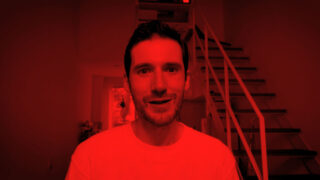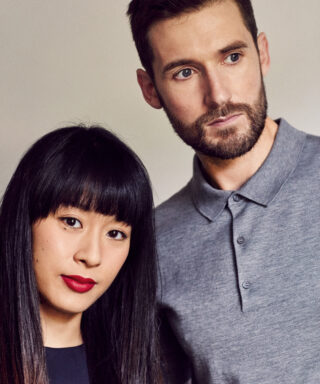Studio Swine
Interview : 1

Grant Gibson [GG]: You’re based in Tokyo. How has the pandemic effected your practice?
Alexander Groves [AG]: It has been quite interesting for us because we work from home and have done for the past decade. So in that sense our working environment hasn’t changed. But the slower pace of things, and having projects put on hold, has given us time to reflect and work on some of our long-term plans. In a curious way it has been a positive thing for us.
GG: What piqued your interest in Connected?
AG: It was an opportunity to work in wood, which is something we haven’t done much before. It’s a beautiful material that’s very appealing. Also we’ve always really admired Benchmark – it’s a chance to work with great craftsmen.
GG: What is it about wood that you enjoy?
AG: We love nature and natural materials. And we love being around wood. It has this warmth, a haptic quality. It also resonates sound nicely. Even when you’re locked indoors it can connect you to nature. So there’s lots to like about timber.
GG: What can we expect from you?
AG: I have a fine art background in sculpture and Azusa Murakami comes from architecture. So we approach things from different perspectives and, really, our work is a synthesis of these two things being brought together. I think there’s a nice opportunity in furniture to bring together the sculptural and the architectural.
“I think there’s a nice opportunity in furniture to bring together the sculptural and the architectural.”
GG: What stage are you at with the project?
AG: We’ve cast our net in a few possible directions. We’re looking at three different options for the chair and around the same amount for the table. Because we’re so lock-off from nature here – we’re in the middle of Tokyo – there are some parks around but it’s not the same as going for a walk in the woods. We miss that and we’re keen to bring it indoors.
GG: Have the three timbers you’ve been asked to consider – red oak, maple and cherry – effected your thinking?
AG: Yes. Before we were in Tokyo, we lived in New York and we’d spend a lot of time going Upstate to the forests. So we became quite familiar with the native trees. I’d say a lot of our approach to this project is remembering very fondly the Upstate landscapes where these timbers are coming from – the East Coast forests. There’s a lot of romance in that area. Rip van Winkle was set there and that part of the world inspired Henry David Thoreau to write Walden about self-reliance and going back into the woods. Generally when we’re doing a project we immerse ourselves in a place. Here we’re immersed in the memory of the woods and Tokyo, so we’re feeding off those influences. We’re keen to bring out all the different qualities that the wood has. The textures and colours and shapes it can form within one piece.
GG: How do you work as a duo? Do you have different areas of responsibility?
AG: There are some areas that are very hard to define and we don’t even remember who came up with what. They are really the result of a lot of dialogue back and forth. I think it’s exciting that the finished result is something that neither of us would have got to on our own. It’s about testing ideas out on each other. It’s a good filtering process too. That said, there are some roles that are easier to define. For instance, I’m particularly interested in materials and science. Azusa is great with form, thinking how things are going to manifest, and the ‘mood’ of it. For us we don’t just think of it as a chair and a table, we’re already thinking what interior it might be in? What would the shoot be like? What kind of house is it in? It quickly builds up into a world, which is what we really like.
GG: How do you practically do things? What’s your process?
AG: We do a lot of drawing and sketching. We’ve filled up a couple of notebooks already. It’s just a good way of thinking really.
GG: You won’t be able to visit Benchmark physically, so it seems to me that trust is an important part of this project?
AG: We really do love visiting manufacturers, having those conversations and discovering things. On the other hand, we’ve just got off a call with them and had a really fascinating talk and learned a lot. So that’s still possible. And we’re quite used to having production outsourced. We used to make everything ourselves but recently our projects have been getting bigger and more complicated. As a result we’ve worked with fabricators from around the world.
GG: Making films is an important part of your practice, it is strange filming yourselves for this?
AG: We’re used to being filmed but, to be honest, we prefer being on the other side of the camera and arranging shoots and thinking about the story boarding. Film for us is usually as important as the finished object because they’re all serving the same thing, which is making a world.
GG: What are you hoping to derive from the project?
AG: It would be nice to make something that we haven’t anticipated yet. We haven’t pinned down a design and it could change quite a bit. It’s also quite exciting that we can keep the piece. Over the past 10 years we’ve lived in quite a few countries and we haven’t really made a home for ourselves. So a chair and a table is a really nice way to start.
